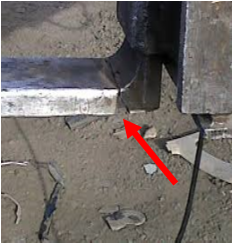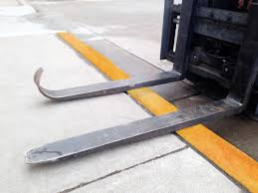Forks that break or show excessive wear pose a serious hazard. Fortunately a thorough pre-use fork inspection can identify these deficiencies before they cause accidents.

Here are six items that your fork inspection should cover:
- Surface cracks: Examine the heel area and welds attaching the mounting components to the fork blades. Visible surface cracks mean the fork should be removed from service. (See red arrow).
- Blade and shank straightness: Use a square to check for straightness. A 48-inch fork should not have more than one quarter-inch deviation on either the blade or the shank.
- Excessive fork angle: The fork angle must be between 87 and 93 degrees.

Blade Damage - Tip levels: The tips of the forks should be close to the same level (within 3% of the fork’s blade length).
- Fork hooks and fork positioning lock for damage: Any damage or a missingpin can cause the forks to shift unexpectedly.
- Blade wear and other damage: A loss of 10% in the thickness of the blade will result in a 20% decrease of thefork’s strength. Be sure to inspect the fork tips as well.
There are several useful tools that can help you assess your forks. For example, Cascade Corporation makes a caliper that can be used to measure fork wear. If you have any questions on inspecting forks, please feel free to contact us.
If you would like to share your experiences/photos of forklift incidents that can educate others on the principles of safe forklift operation please send them to: bhulberg@D2000safety.com
We will not publish company or individuals names.
Newsletters may or may not open automatically, depending on the web browser settings you are using.